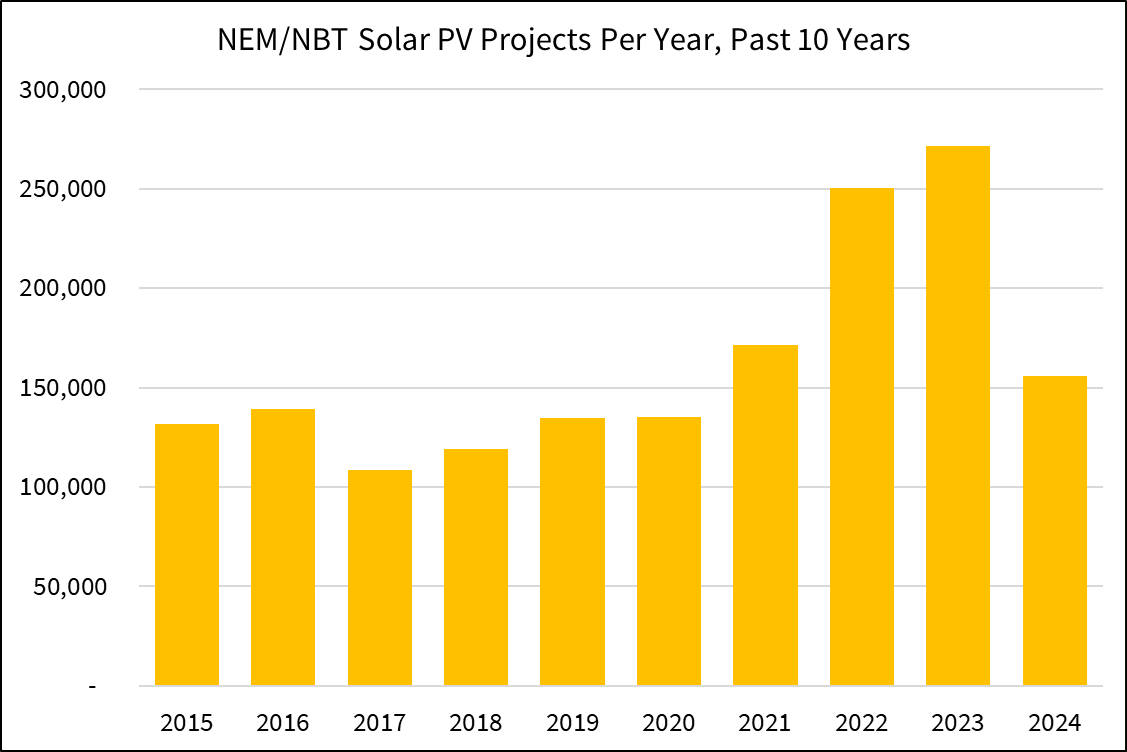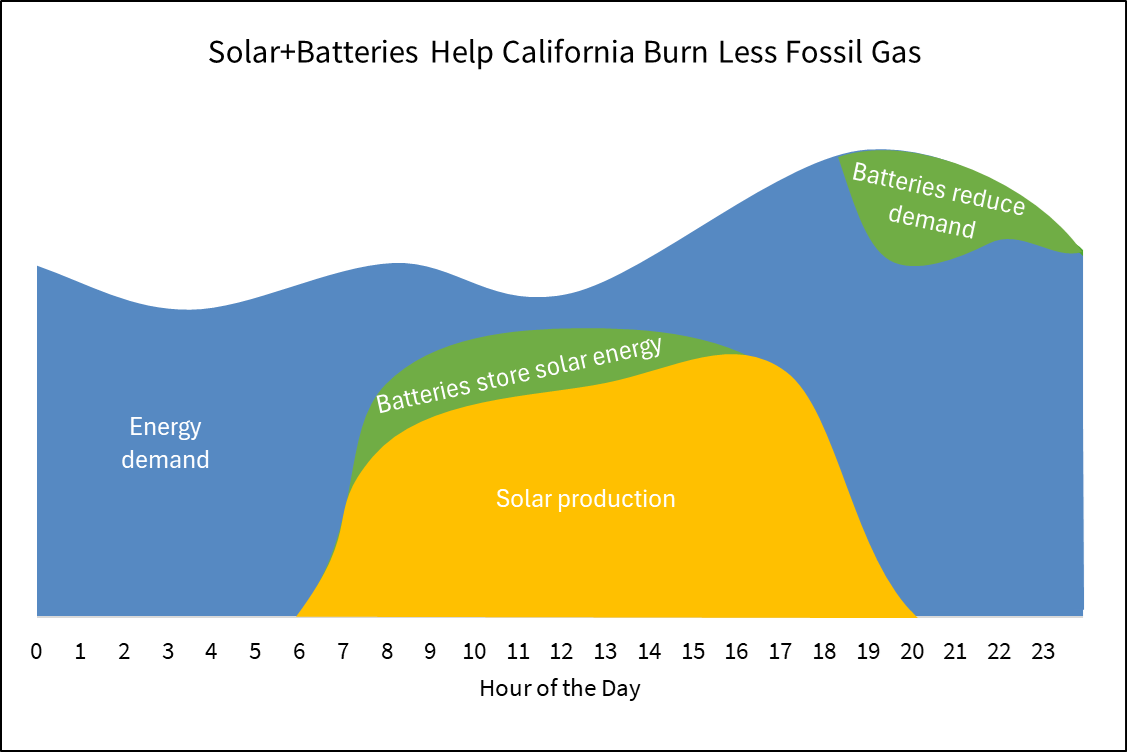Net Energy Metering and Net Billing
Key Information
California is the national leader in customer-sited solar, with more than one-third of U.S. capacity as of September 2023. About 137,000 solar systems were installed in each of the past 10 years on average, except 2022 and 2023, when more were installed in anticipation of the closure of net energy metering (NEM) tariffs. (This started in 2021, raising the average.)

California has abundant solar energy during the day. But as the sun sets and daily energy usage peaks, California calls on polluting fossil gas power plants. The nearly 70 percent of net billing tariff (NBT) customers who paired batteries with their solar by the end of 2024 are helping reduce the need to use these plants.

Switching to electric cars and appliances (such as induction stoves, heat pump water heaters and HVAC systems, and clothes dryers) is key to emitting less greenhouse gas and slowing climate disruption. The rate designs used by NBT customers have low daytime prices that let solar adopters affordably power these electric options. Also, the NBT raises electric rates less than NEM tariffs, keeping electric options affordable for millions of California ratepayers. Thus, the NBT supports the CPUC’s other work to decarbonize end uses through electrification. For more information, visit the CPUC’s Building Decarbonization and Transportation Electrification webpages.
For further data on the number of projects and capacity of customer-sited renewable energy generation, please visit the California Distributed Generation Statistics website.
Note: The content on this webpage applies in the territories of the large electric investor-owned utilities (IOU): Pacific Gas and Electric Company (PG&E), Southern California Edison Company (SCE), and San Diego Gas & Electric Company (SDG&E). Also, this webpage only covers retail transactions for energy (not "non-export" interconnection, energy sales at avoided cost, or wholesale market transactions).
Net Billing
Since April 15, 2023, customers applying for interconnection have taken service on the new net billing tariff (NBT) pursuant to D.22-12-056. The NBT applies to the types of renewable electrical generation facilities that would previously have used standard NEM tariffs. The IOUs refer to the NBT as the “Solar Billing Plan.”
As with NEM, onsite generation is first used to serve onsite load under the NBT, offsetting energy costs. The NBT’s major difference from NEM 2.0 is that under the NBT, compensation for excess generation exported to the electric grid is applied to a customer’s bill at a rate reflecting the value of this generation to the grid. The value of the export compensation (which the IOUs term “Energy Export Credits”) is usually lower than the retail rate (see PG&E, SCE, and SDG&E rates), but can rise above the retail rate on late summer evenings. Customer-generators can maximize bill savings under the NBT by installing battery storage along with their generation, so they can use or export stored energy during these high-value hours. There are some additional aspects of the NBT that are different from NEM 2.0:
- Export compensation adder: Residential PG&E and SCE customers who apply to interconnect NBT facilities to the grid before the end of 2027 receive slightly higher-than-normal bill credits for exported energy for nine years. (SDG&E customers are excluded because their solar systems generate more bill savings due to SDG&E’s higher electric rates). Customers who are required to add solar (e.g., by California’s building code for new construction) do not receive the adder.
- “Electrification” TOU rate requirement: Customer-generators are required to take service on a specific TOU rate with lower off-peak prices and higher on-peak prices than other TOU rates. These rates reduce GHG emissions and strain on the electric grid by discouraging energy use at peak demand times of day, and they encourage customers to use electric vehicles and appliances by charging less for energy at other times. The rates currently approved are E-ELEC for PG&E, TOU-D-PRIME for SCE, and EV-TOU-5 for SDG&E.
- Nine-year legacy period: The original customer who causes a generation facility to be interconnected to the grid under the NBT is guaranteed the use of the NBT tariff for nine years. Customer-generators who move to the NBT from a previous NEM tariff are not eligible for the NBT legacy period.
- Monthly bill payment: Payment for bill charges is due monthly, so that customers are not surprised by a large annual bill after their true-up date. In months when there are excess solar bill credits, the credits roll over to following months, until the annual true-up.
For more information on the NEM Revisit Rulemaking (R.20-08-020) and NBT, please visit the NEM Revisit webpage.
Net Energy Metering
Under NEM tariffs, participating customers receive bill credits for excess generation that is exported to the electric grid during times when it is not serving onsite load. These bill credits are applied to customers' monthly bills at the retail rates (including generation, distribution, and transmission components) that the customers pay for energy consumption according to their otherwise applicable rate structures. These tariffs are closed to new enrollments.
NEM customer-generators pay the same non-bypassable charges for public services as other IOU customers, including Department of Water Resources bond, public purpose program, nuclear decommissioning, and competition transition charges. These charges fund important programs such as low-income and energy efficiency programs. NEM customer-generators are exempt from standby charges.
At the end of a customer's 12-month billing period, any balance of surplus electricity is trued up at a rate based on the recent market rate for energy resulting in "net surplus compensation" (NSC). The NSC rate is approximately $0.02 to $0.03 per kWh (for up-to-date NSC data, follow these links: PG&E, SCE, SDG&E). This rate structure was established in Commission Decision (D).11-06-016 pursuant to Assembly Bill (AB) 920 (Huffman, 2009).
Pursuant to SB 656 (Alquist, 1995), the CPUC created the first NEM tariff, commonly known as “NEM 1.0,” in 1996. Customer-generators interconnected their systems to the grid under the NEM 1.0 tariff between then and the 2016-2017 NEM 1.0 sunset dates. The CPUC created the second NEM tariff, “NEM 2.0,” in 2016 pursuant to AB 327 (Perea, 2013). For information on the NEM 2.0 Rulemaking, R.14-07-002, please visit the NEM Successor Tariff webpage. To align NEM customer costs more closely with non-NEM customer costs, NEM 2.0 requires customer-generators to:
- Pay a one-time interconnection fee. Customer-generators with facilities under 1 MW pay a fee based on each IOU's historic interconnection costs. PG&E’s fee is $145; SCE’s $94; and SDG&E’s $132. Customer-generators with systems over 1 MW pay an $800 fee and pay for all transmission/distribution system upgrades.
- Pay non-bypassable charges in each metered interval. Customer-generators pay small charges on each net kilowatt-hour (kWh) of electricity they consume from the grid in a metered interval.
- Transfer to a time-of-use (TOU) rate. Customer-generators must take service on a TOU rate to participate in NEM 2.0.
Key differences between the three standard NEM/NBT tariffs are described below.
| NEM 1.0 | NEM 2.0 | NBT | |
| Eligible import rate schedule | Any | TOU rates | Specific “electrification” TOU rates |
| Onsite use of generated energy avoids energy imports |
Yes | Yes | Yes |
| Basis of credits for retail energy exports before true-up |
Import rates | Import rates | CPUC Avoided Cost Calculator values (usually lower than import rates) |
| Basis of credits for net surplus energy at true-up | Wholesale price of energy | Wholesale price of energy | Wholesale price of energy |
| Basis of non-bypassable charges calculation |
Net energy consumed (imports minus exports) in a year |
Net energy consumed in a metered interval (1 hour for residential and 15 minutes for nonresidential customers) | All energy imports |
| Interconnection fee | None | $94-145 | $94-145 |
| Billing and true-up period | Annual billing, annual true-up (both charges and credits roll over for 12 months) |
Annual billing, annual true-up (both charges and credits roll over for 12 months) | Monthly billing (pay monthly); annual true-up (credits roll over for 12 months) |
| Installation size limit | Customer’s annual electric load with limited exceptions; capped at 1 MW | Customer’s annual electric load with limited exceptions | Customer’s annual electric load plus up to 50% if customer attests to need |
Regulatory Documents
Listed here in reverse chronological order (most recent first) are selected CPUC decisions and other documents relevant to NEM and the NBT. Please contact us if you have any suggestions for additions.
- D.24-09-051: Denies rehearing of and modifies Resolution E-5301
- D.23-11-068: Plans an evaluation of the NBT
- D.22-12-056: Adopts the NBT
- Resolution E-5301: Approves the IOUs’ proposed net billing tariffs
- D.22-07-001: Limits the NEM facilities allowed to interconnect to the transmission grid to those less than or equal to one megawatt of capacity
- D.21-02-007: Adopts guiding principles for the NEM revisit proceeding
- D.20-06-017: Allows storage devices to charge from the grid before Public Safety Power Shutoffs and removes the large storage sizing limit for three years
- D.19-01-030: Modifies the D.14-05-033 rules for large storage devices
- D.18-02-008: Modifies the D.16-04-020 bill credit estimation methodology
- D.16-04-020: Adopts estimation and metering options for small storage devices
- D.16-01-044: Adopts the NEM successor tariff (NEM 2.0)
- Resolution E-4792: Adopts the IOUs' proposed NEM 2.0 tariffs
- D.14-05-033: Creates rules for pairing storage devices with NEM generation facilities
- D.14-03-041: Establishes a 20-year transition period for NEM customers
- Resolution E-4610 and E-4665: Authorize the IOUs to implement NEM aggregation and track interconnection costs
- D.12-05-036: Clarifies the calculation of the NEM 1.0 cap
- D.11-06-016: Adopts a net surplus compensation rate
- D.09-08-026: Adopts a cost-benefit methodology for distributed generation
- D.08-02-002: Directs the IOUs to provide NEM to Community Choice Aggregator customers
- D.05-08-013: Adopts rules for facilities with both NEM-eligible and -ineligible generators
- Resolution E-3992: Implements D.05-08-013
- D.02-03-057: Rules on NEM interconnection fees and directs the IOUs to track interconnection and distribution system modification costs
Small Utility NEM and Net Billing Tariffs
The small IOUs have their own tariffs, designed and approved separately from those described above. Liberty Utilities has a NEM tariff. Bear Valley Electric Service Division (BVES) has an NBT called the Distributed Generation Service Tariff. PacifiCorp d/b/a Pacific Power has an NBT called the Net Billing Service. Selected relevant CPUC decisions and other documents:
- D.20-01-008: Approves BVES distributed generation service tariff
- D.20-01-007: Approves Pacific Power net billing tariff
- Resolution E-4854: Authorizes small IOUs to implement NEM aggregation (June 2017)
Contact Us
You are welcome to contact the CPUC if you have any questions about information on this webpage. For press inquiries, please contact the CPUC News and Outreach Office. Additional helpful information for prospective or existing solar customers can be found on these webpages:
